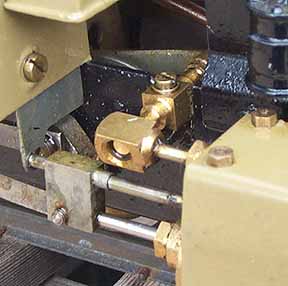
Back to Sidestreet Bannerworks
January 2003
Roundhouse “Old Colonial”
by Marc Horovitz

Roundhouse Engineering introduced “Old Colonial”, a freelance 0-6-0 tank engine, in 1985. This was the fifth locomotive in Roundhouse’s stable and the company’s first six-wheeled engine. Mechanically, the locomotive was similar to the “Lady Anne” series, with the addition of the third axle, a rear bunker, and some unusual details for a British engine, including an American-style pilot, a large headlight, and a diamond stack. It was because of these details that the engine was dubbed “Old Colonial”.
The engine features Roundhouse’s standard, double acting, D-valve cylinders, reversed by slip eccentrics on the third axle. The roof and back wall are removable as a unit for access to the cab. The backhead is spare, containing only a throttle lever, pressure gauge, and blowdown valve. A large displacement lubricator sits on the footplate on the lefthand side. The boiler is a standard pot, shielded by a firebox concealed in the side tanks, and fired by a four-wick alcohol burner. Fuel is stored in a tank under the cab.
Of the details, perhaps the most interesting is the large, working headlight. It is powered by a 9V battery hidden between the frames behind the front beam. There is a small toggle switch built into the frame on the left side, just below the smokebox. The headlight, which has a frosted lens. produces a pleasant yellow glow. Other details include three dummy wood loads of cast resin, a pump on the right side of the smokebox, sand boxes on the front of the tanks, jacks and a toolbox on the pilot deck, and dummy hatch covers on the side tanks. My engine, Roger the Scoundrel, is of earliest production. The side tanks were uninsulated and the hatch covers were white-metal castings -- a bad combination. It didn’t take long for the heat of the fire to get to the hatch covers and melt them, causing molten white metal to drip onto the side rods. The covers caved in upon themselves and today, while still present, are little more than empty shells of paint. Later engines had turned-brass hatch covers and (I believe) insulated side tanks. The detail parts tend to come off and get lost, as they were essentially just glued onto paint.
While this engine, visually, is not one of my favorites, it runs with the same determined reliability of all Roundhouse engines. It was finally discontinued in 1988.
The run
A cold, cloudy day, today, with temps in the high 30s and a stiff breeze blowing from the west -- not the best day for steaming. This engine hadn't been run in maybe 15 years or so and its mechanism was completely frozen. With the application of some WD-40 and some gentle prodding, it loosened up considerably.
After the usual preparation ritual, I lit the fire and went off to wipe down the track. In eight minutes or so, the pressure gauge was showing a little steam. Then the safety blew, at under 20 pounds. That wasn't good. I opened the throttle and let the condensate run out. The engine moved off and made a weak lap around the track, with the safety blowing the whole time. I closed the throttle and adjusted the safety valve to its intended blow-off pressure of 45 psi. The loco perked up immediately and the rest of the run was faultless. The alcohol filler tube projects out the side of the cab, so refueling could actually be done on the fly.
The wicks probably could have been packed more tightly, as there was a fair amount of visible flame coming up around the sides of the boiler. The paint on the uninsulated side tanks continued to suffer and one side was badly discolored and cracked by the end of the run. Also, the headlight, which had never been mounted well to begin with, and now has a screw missing, drooped more and more as the run progressed.
These things aside, the run was smooth and steady, everything we have come to expect from a Roundhouse locomotive. The weather seemed to have little effect and the engine was retired after 40 minutes or so.
|
|
|
| Builder | Roundhouse Engineering (England) |
| Date built | 1985 |
| Gauge | 45mm (gauge 1) |
| Scale | 16mm |
| Boiler | Pot |
| Fittings | Safety valve, throttle, pressure gauge, blowdown / vacuum tap |
| Fuel | Alcohol |
| Blow-off pressure | 45 psi |
| Cylinders | Two double-acting D-valve |
| Reversing gear | Slip eccentrics |
| Lubricator | Displacement |
| Dimensions | 12-1/4" long; 4-1/2" wide; 6-1/8" tall |




Right: Few accouterments adorn the backhead. The red valve is a blowdown, which can also be used as a vacuum tap to refill the boiler. The black pipe is the filler tube for the alcohol burner.
Far right: The working headlight -- a nice feature.
Below: Underneath, the engine is pretty conventional. Slip eccentrics drive the valves while a four-wick alcohol burner heats the boiler. The brass plate behind the pilot contains the headlight's battery.




Back to Sidestreet Bannerworks
This page and its contents Copyright Sidestreet Bannerworks, 2003